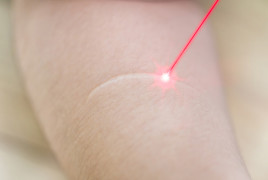Vitiligo: Signs and symptoms
Loss of skin color can appear anywhere
Vitiligo causes loss of your natural skin color. Your dermatologist may call this “loss of pigment” or “depigmentation.” We can lose pigment anywhere on our bodies, including our:
Skin
Hair (scalp, eyebrow, eyelash, beard)
Eyes
Mouth (inside)
Genitals
Most people who get vitiligo lose color on their skin. The affected skin can lighten or turn completely white. Many people do not have any other signs or symptoms. They feel completely healthy.
A few people say that the skin affected by vitiligo itches or feels painful.
Living with vitiligo can cause other symptoms, such as low self-esteem and depression that is hard to beat. This can happen regardless of the amount of color loss or type of vitiligo.
Vitiligo
It is common to have vitiligo on the hands.

Vitiligo can progress
With time, some people see their vitiligo cover a large area.

Vitiligo types and subtypes
If you are diagnosed with vitiligo, your dermatologist may tell you what type and subtype you have.
Types
Today, most doctors recognize two types of vitiligo:
| Type | Traits |
|---|---|
| Segmental vitiligo Also called:
|
|
| Non-segmental vitiligo
|
|
Types of vitiligo
The child on the left has the most common type, non-segmental vitiligo. The child on the right has segmental vitiligo.

Subtypes
The subtype tells you how much vitiligo appears on the body. The vitiligo subtypes are:
Localized. One or a few spots or patches appear, but these are limited to one or a few areas of the body.
Generalized. Most people develop this subtype, which causes scattered patches on the body.
Universal. Most pigment is gone. This is rare.
There is no way to predict how much color a person will lose. Color loss can remain unchanged for years. Some people see patches enlarge and new patches appear. On a rare occasion, the skin may regain its lost color without treatment.
Related AAD resources
Images
Image 4 used with permission of Journal of the American Academy of Dermatology. (J Am Acad Dermatol 2010; 62:945-9)
References
Mazereeuw-Hautier J, Bezio S, Mahe E et al. “Segmental and nonsegmental childhood vitiligo has distinct clinical characteristics: a prospective observational study.” J Am Acad Dermatol; 62: 945-9.
Ortonne JP, “Vitiligo and other disorders of hypopigmentation.” In: Bolognia JL, Jorizzo JL, Rapini RP, et al. editors. Dermatology, 2nd ed. Spain, Mosby Elsevier; 2008. p. 913-20.
 Think sun protection during Skin Cancer Awareness Month
Think sun protection during Skin Cancer Awareness Month
 How to care for your skin if you have lupus
How to care for your skin if you have lupus
 Practice Safe Sun
Practice Safe Sun
 Sunscreen FAQs
Sunscreen FAQs
 Fade dark spots
Fade dark spots
 Hidradenitis suppurativa
Hidradenitis suppurativa
 Laser hair removal
Laser hair removal
 Scar treatment
Scar treatment
 Botox
Botox
 Kids' camp - Camp Discovery
Kids' camp - Camp Discovery
 Dermatologist-approved lesson plans, activities you can use
Dermatologist-approved lesson plans, activities you can use
 Find a Dermatologist
Find a Dermatologist
 Why choose a board-certified dermatologist?
Why choose a board-certified dermatologist?